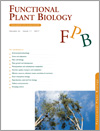
Functional Plant Biology
Volume 44 Number 11 2017
FP17077Relationships between climate of origin and photosynthetic responses to an episodic heatwave depend on growth CO2 concentration for Eucalyptus camaldulensis var. camaldulensis
It is uncertain how elevated CO2 will affect photosynthesis during extreme events. Seven genotypes of Eucalyptus camaldulensis var. camaldulensis were grown in 400 or 640 parts per million CO2, and photosynthetic electron transport, stomatal conductance and net CO2 uptake were measured before, during and after a 4-day heatwave. The correlations between climate of origin and physiological responses depend on growth CO2, which makes it difficult to predict species responses to episodic aspects of climate change.
FP17022Changes of enzyme activities related to oxidative stress in rice plants inoculated with random mutants of a Pseudomonas fluorescens strain able to improve plant fitness upon biotic and abiotic conditions
Rice is a staple food in many countries and local production is carried out under unfavourable conditions, so effective and affordable alternatives to enhance local production are mandatory to palliate hunger. The underlying hypothesis is that certain beneficial bacterial strains can boost plant’s adaptive metabolism to overcome environmental limitations, so this study aimed to identify bacterial genes involved in beneficial effects on plants by creating random mutants of an effective Pseudomonas strain by evaluating loss of protection against salt stress in rice, and growth of tomato. Mutants were mapped and putative responsible genes sequenced. This study reveals the effectiveness of beneficial bacteria on two relevant crops, phylogenetically distant, so it appears as a challenging alternative to meet food security.
FP17110The temperature response of leaf dark respiration in 15 provenances of Eucalyptus grandis grown in ambient and elevated CO2
Leaf respiration (R) is an important determinant of tree and forest function, yet the impacts of rising atmospheric CO2 on leaf R remain poorly understood. We found that leaf respiration is largely unaffected by elevated CO2, and is relatively similar across seedlings of geographically and climatically diverse populations of Eucalyptus grandis. We conclude that elevated CO2 is unlikely to change leaf R in E. grandis.
FP17096Variation in photosynthetic traits related to access to water in semiarid Australian woody species
Soil water availability is a key factor limiting rates of carbon assimilation in plants. However, we found that as water availability declined, investment in foliar nitrogen, photosynthetic capacity and intrinsic water-use efficiency increased across eight co-occurring tree species in semiarid Australia. We conclude that differential access to water is an important factor driving variability of traits related to carbon gain.
FP16429Different water relations between flowering and leaf periods: a case study in flower-before-leaf-emergence Magnolia species
The mechanism by which flowers regulate their function and structure to maintain water balance is unclear. We found that flowers of two Magnolia species consumed less than half the water that leaves did, and explored different hydraulic strategies in flowers and leaves to sustain hydraulic safety. This study contributes new knowledge to the field of floral hydraulics.
FP17060Relative contribution of photorespiration and antioxidative mechanisms in Caragana korshinskii under drought conditions across the Loess Plateau
Photorespiration plays a positive role in coping with drought stress in plants. Here, the drought-tolerant plant Caragana korshinskii responded to drought with high photorespiration and strong antioxidative system that may improve the ability of coping with drought. These findings help us further understand how photorespiration and antioxidative systems co-ordinate to improve the tolerance to drought in plants.
FP17066Vegetative desiccation tolerance of Tripogon spicatus (Poaceae) from the tropical semiarid region of northeastern Brazil
Resurrection plants exposed to extreme dehydration are able to recover physiological functionality after rehydration, because of their ability to induce protection and repair mechanisms. We demonstrated that the Brazilian semiarid grass Tripogon spicatus is able to tolerate complete vegetative dehydration, maintaining chlorophyll content and increasing photosynthetic rates after rehydration.
FP17079Divergence in plant water-use strategies in semiarid woody species
The stable co-existence of a diversity of plant species within a single biome is possible if the species access different resources. In semiarid Australia we found that co-occurring tree species had differing access to water, resulting in multiple plant water-use strategies in this water-limited environment. These differing strategies have important implications for the survival of these species under drought.



